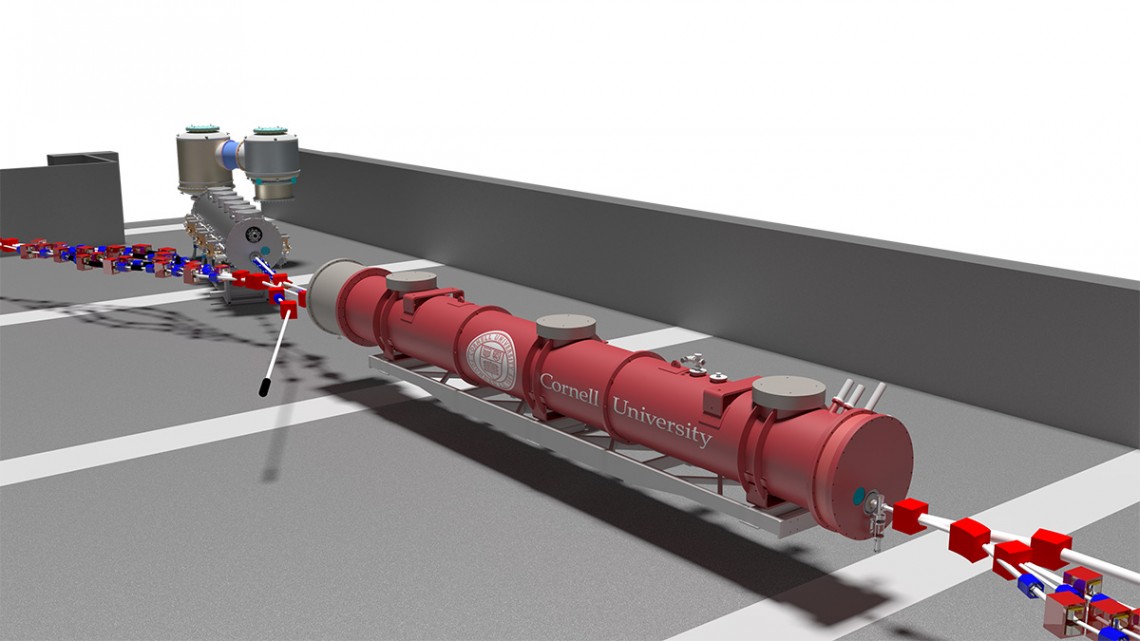
Artist's rendering of the main accelerator components, including the main linac cryomodule (red) and the beam stop (cylinders upper left), in Wilson Lab.
Accelerator project gets push from National Academy of Sciences
By Tom Fleischman
A National Academy of Sciences, Engineering and Medicine (NAS) committee has endorsed the idea of building an electron-ion collider (EIC) in the United States, for the purpose of expanding understanding of the fundamental building blocks of matter.
The EIC would be one of the largest scientific instruments in the country and used to study atomic nuclei – what atoms are made of, and the structure of the visible matter in the universe. The device would allow scientists to explore fundamental questions using precisely controlled collisions of high-energy ion and electron beams, which would produce 3D pictures of material inside atomic nuclei.
As a particle accelerator, the EIC is technically challenging, and science being conducted at Cornell’s energy recovery linear accelerator (ERL) at Wilson Synchrotron Laboratory will play a significant role in its success.
This report, issued July 24 by the NAS Committee on U.S.-Based Electron-Ion Collider Science Assessment, also notes that two U.S. Department of Energy national laboratories have the necessary accelerator infrastructure and expertise for an EIC: Brookhaven National Laboratory on Long Island and the Thomas Jefferson National Accelerator Facility in Newport News, Virginia.
Cornell has been developing ERL capabilities for 15 years. In November 2016, New York state provided funds to support the construction of a new energy recovery linear accelerator (“linac”) at Cornell, slated for completion in 2020. The Cornell-Brookhaven ERL Test Accelerator, or CBETA, is a project aimed at developing a critical EIC need: a means to “cool” (more tightly focus) a beam of ions. As the committee report notes, “Energy recovery linacs (ERLs) … presently offer the only credible concept for electron cooling of high-energy colliding beams.”
The report highlights the importance of CBETA, noting that it “will pioneer several energy-saving concepts” in accelerator design, including energy recovery and re-use, and the use of permanent magnets, which require no electric power, instead of electromagnets.
John Jowett, accelerator physicist at the European Organization for Nuclear Research (known as CERN) and a member of the EIC committee, said ERL technology would be used in the EIC design mainly “to provide the intense electron beams that are required in various cooling schemes,” he said.
“Conventional electron linacs (linear accelerators) would be far too expensive to operate,” Jowett said, “while the energy recovery linacs are much more affordable.”
Physics professor Georg Hoffstaetter, Cornell’s principal investigator on the CBETA project, is excited about the essential part CBETA plays for a future EIC but also points out that regardless of whether DOE decides to move forward with building an EIC, the CBETA project could yield benefits in many areas of physics. In fact, there is so much international interest that collaborators from Brookhaven, other U.S. national labs and labs from Germany and England have already sent scientists to Cornell. And visits by researchers from Japan, France and Switzerland have been announced.
Ritchie Patterson, professor of physics and director of the Cornell Laboratory for Accelerator-based Sciences and Education (CLASSE), said that in addition to assisting the EIC, CBETA capabilities are expected to propel a broad range of science, biomedical advancement and economic development.
“For us, it’s a fantastic scientific opportunity,” Patterson said. “To some extent, it’s a crown on top of everything we’ve done in the past. And it’s a cornerstone for a whole new research program going forward.”
The ERL, which Cornell physicists developed with previous funding from both the state and the National Science Foundation, was first imagined more than 50 years ago by Cornell physicist Maury Tigner.
Researchers use high-energy, highly focused beams of electrons for all sorts of applications – high-energy physics, advanced light sources and medical discovery, to name a few. And with its Center for Bright Beams – the aim of which is to decrease the cost of key accelerator technologies while simultaneously vastly increasing the intensity of charged particle beams – Cornell is in the vanguard of this science.
Particle accelerators come in two shapes, circular and linear, with each having its own set of advantages and drawbacks. A ring, such as Cornell’s 760-meter synchrotron, produces a very intense but “hot” (scattered) beam, while a linear accelerator beam is less powerful but “cold” (more focused).
An ERL – such as CBETA – combines the best attributes of both, Patterson said. It captures the energy of a used electron beam in order to accelerate a new one.
“An ERL gives you a beam that is both very intense and very cold, with a modest energy footprint,” she said. “This is an economical, energy-efficient way to enable high-power accelerators that just would not be possible any other way.”
In addition to its use in a potential EIC project, CBETA could also be a compact hard X-ray source that could, in principle, deliver beams with energies higher than what is currently available at the Cornell High Energy Synchrotron Source (CHESS), extending the range of Cornell’s synchrotron source.
“Nobody else has conceived or executed an energy recovery linac nearly this ambitious,” Patterson said. “Cornell is recognized as a world leader in this technology; we’re pushing the envelope here.”
Media Contact
Get Cornell news delivered right to your inbox.
Subscribe
